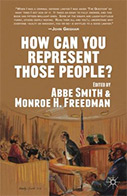How Can You Represent Those People?

Editors: Abbe Smith and Monroe H. Freedman
Publisher: New York: Palgrave Macmillan, 2013. 244p.
Reviewer: Marc Bookman | November 2013
In the collection of essays entitled How Can You Represent Those People?, fifteen writers struggle to answer a question that has plagued all manner of criminal defense attorneys since the earliest days of the Constitution, a question that echoes off the crystal glasses of every cocktail party, and causes consternation among the best thinkers and practitioners who contemplate the presumption of innocence. And that question is …well, yes, the title gives it away. The contributors see the issue in a host of different ways, however, and that makes for some fascinating reading.
Before I get too deeply into this review, though, I feel the need to briefly provide my own background, which both colors my perspective and hopefully provides some insight as well. I was an attorney in the Defender Association of Philadelphia for 27 years, and since then I’ve run a small non-profit dedicated to the defense of death penalty cases. This gives me a certain amount of experience with the question at hand, and might in fact excuse me if I found the essays boring or trite. The fact that I didn’t is a tribute to the creativity and insight the selected writers have brought to the issue.
Great criminal defense attorneys learn the same painful lesson early on – if you play on the other side’s field, you’re going to lose. Or, more specifically, your client is going to lose. Thus, it is not surprising to see that the essayists in this collection tend to rephrase the question to suit their needs. How can you defend those people? Abbe Smith, the co-editor and contributor, and Robin Steinberg, the Director of the Bronx Defender, prefer to ask: how can you not defend those people? Colorado defender Ann Roan and law professor Angela Davis think of “those people” as themselves; Joseph Margulies, best known for his work representing detainees at Guantanamo Bay, doesn’t believe “those people” exist at all. Paul Butler, the lone prosecutor in the collection, takes on what he claims is the even more difficult question: how can you prosecute those people? It might have been interesting to read other prosecutors’ perspectives on the title question as well.
Once the writers have established their own comfort level with the question at hand, they are almost universally compelling in their justifications. Indeed, most of the essayists don’t even feel a need to justify; the great lawyer Michael Tigar, referencing his appointment in the Oklahoma City bombing case, simply notes that he “was appointed by the court,” as if anything more is superfluous. David Singleton, who runs a non-profit and writes about representing sex offenders, believes in the “possibility of redemption.” Ann Roan says she likes a good fight, Robin Steinberg believes it is necessary to oppose power; and Professor Alice Woolley, in the most analytical and academic of the essays, divides her answer in two parts: how can anyone represent those people, and how can anyone, personally, represent those people? Woolley sees the defense attorney as the conduit for the story of the accused, just as the prosecution is the conduit for a short and criminal story about the accused. Her own personal reason — told through the prism of her nine year old autistic son and the unfair criticism she perceives as his mother — is that “criminal defense is a good thing to do.” By this she means that good defense lawyers are compassionate and empathetic, they stand up for the underdog, they hold those in authority to account. Maybe it’s just as simple as that.
And then maybe again it’s not. Professor Vida Johnson details the civil rights battles of her grandparents, and recognizes today’s battles over excessive incarceration of minority communities as a logical extension of the fight to end Jim Crow – “I do this work because the criminalization of the black community has replaced the Jim Crow segregation of my grandfather’s time.” Co-editor and law professor Monroe Freedman addresses a different aspect of modern racism in the criminal justice system, by discussing how the O.J. Simpson defense team exploited the racist attitudes of the lead detective in the case: “Although the defense did indeed play the race card, the state of California dealt it, by knowingly employing and promoting an outspoken racist on the police force and by showcasing him as a principal witness for the prosecution. For my part, I would rather live in a society in which a guilty O.J. Simpson goes free than one in which police detectives like Mark Fuhrman wield the enormous powers of the state.”
Death penalty lawyers Meghan Shapiro and William Montross find their own humanity enhanced through the representation of their clients; they see the grey that lies between the visceral pain of the victim’s family and more hidden but no less real pain that their own client has suffered. And perhaps it is because they are death penalty lawyers that they have particular insight into the trauma that is just below, and often bubbles to the surface, of criminal prosecutions. As they themselves note, “[o]rdinary criminal defense lawyers do not expose themselves to such magnitudes of trauma over and over again.” Their justification for subjecting themselves to this level of pain is that they are sustained by the clients’ stories: “We find the fragility and resilience in our clients, and in the process discover the same in ourselves.” Barbara Babcock, who reprises her seminal essay “Defending The Guilty,” mines this same territory. And thankfully there is very little blather about the presumption of innocence in this volume – indeed, in a take-off of the attention-grabbing Innocence Projects, Abbe Smith proudly refers to what she does as “The Guilty Project.”
A few of these essays stand out. Joseph Margulies takes the reader on a Howard Zinn–like “People’s History of the American Justice System,” or so it seems. He begins his essay by articulating the real question behind the book, at least as this reviewer sees it:
The cultural assumption behind the ubiquitous question asked of every criminal defense lawyer is that “those people” aren’t like “us.” Otherwise the question makes no sense. The decision to represent one of us is easy; only the decision to represent one of them is a puzzle. At its root, therefore, the question is really about who is inside the magic circle and who is out, for it is only when one group is perceived as outside that its claims are viewed as a demand on the community, rather than a demand by the community.
And Tucker Carrington, a former public defender who now runs the Mississippi Innocence Project, shows us how the realities of the criminal justice system, and the realities of those who work on the defense side, are not always as they seem. This is an essay that should be read, especially by criminal defense attorneys, Yesterday, Today, and Tomorrow. To understand the reference, you’ll have to buy the book.
There are a few nits to pick as well. For starters, no one takes on the single most demanding aspect of criminal defense work, which is the representation of the seriously mentally ill. The delicate line between client autonomy and protecting a client from his own terribly impaired judgment is the most difficult one to walk, especially in serious and violent felony or death penalty representation. While our courts and even some defense ethicists are tilting in the direction of client decision-making even in the face of overwhelming evidence and even when the client’s own life is at stake, it is likely those same folks have spent very little, if any, time trying to persuade a severely impaired murderer to spend much or all of his life in prison rather than pursue a path that will ultimately lead to a death sentence. This is where the rubber meets the road for that ultimate of cocktail questions, How Can You Represent That Person?
Which leads me to my next nit, the inclusion of an essay by Alan Dershowitz. While his piece is readable and even entertaining, and while he is no doubt one of the smartest and most able defense practitioners of our time, it is ironic that a man who coined the term “The Abuse Excuse” chooses to criticize death penalty lawyers for falling asleep at trial or failing to do any investigation. Not that the criticism isn’t well founded; rather, the comments might better resonate from a writer with greater insight than to categorize the incredible pain and trauma our clients have suffered in their past as “an excuse.” Such thinking is perhaps the opposite of “client-centered.”
Finally, there is inordinate representation in this collection by graduates of the Public Defender Service (PDS) of Washington, D.C. As Tucker Carrington noted, he “was simply taking advantage of an embarrassment of riches. To work at one of the best public defender offices, with a stable of investigators, law clerks, and helpful engaged colleagues and a low caseload, was a no-brainer.” Let’s just say that being a lawyer at PDS is not exactly working in the trenches, and leave it at that.
But these complaints are inconsequential to the whole. The collection itself is a marvel of different and worthwhile insights that make this volume an important one to anyone with the slightest interest in criminal law. If you don’t find the essays interesting, maybe you should focus instead on those fascinating corporate takeovers and class action suits.
Marc Bookman is Director of the Atlantic Center for Capital Representation, in Philadelphia.


